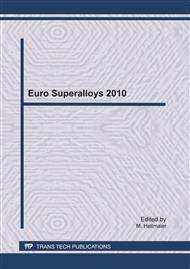p.96
p.102
p.108
p.114
p.120
p.126
p.132
p.138
p.144
The Microstructure Changes in IN713LC during the Creep Exposure
Abstract:
Nickel-based creep resisting alloys (strengthened by γ´) are the basic materials for high-temperature constructional parts in aircraft engines and energy units. These parts are exposed to combined effects of mechanical stresses, high temperature and dioxide-corrosion conditions. The microstructure changes of cast polycrystalline Ni-based superalloy IN713LC after creep exposure were studied. Three specimens with three different diameters were used for creep tests. The degradation stage (damage parameter π) was determined for all parts of specimens. Individual parts of specimens were metallographic observed and analyzed by image analysis after rupture. The results were compared with model of stress distribution in the specimen with potential damage in the centre of the specimen.
Info:
Periodical:
Pages:
120-125
Citation:
Online since:
July 2011
Authors:
Keywords:
Permissions:
Share:
Citation:


